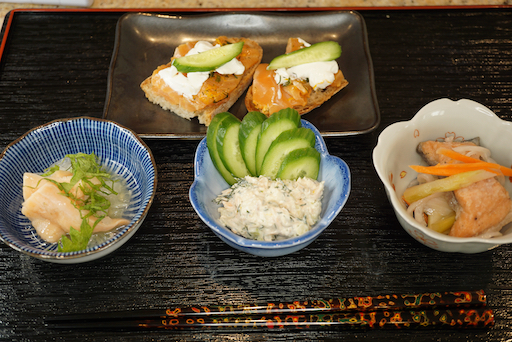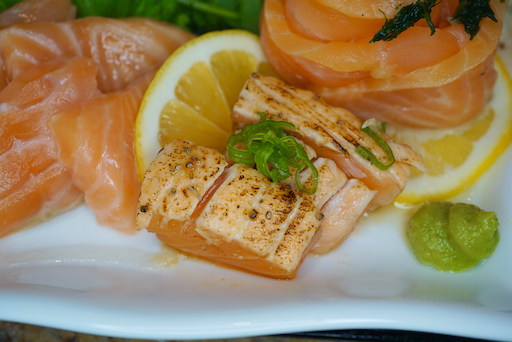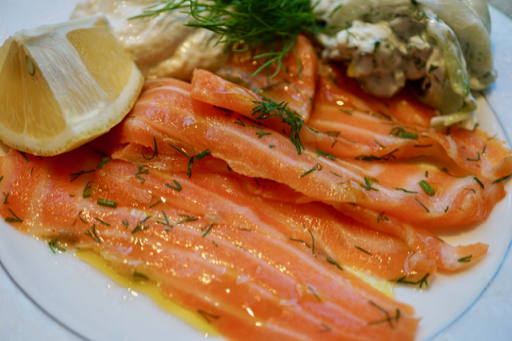Although I secretly aspire to come up with 6 appetizers to start a meal like we enjoyed at two special izakayas, "
Suiko" 酔香 or "
Shuhai" 酒杯 in Japan, my appetizer count usually falls short. But one evening I found I could fairly easily come up with a set of
5 appetizers. After giving it some thought I realized I could make one more for a total of six. Yay! The extra dish, however, did not make the group pic. Its portrait is, nonetheless, shown below.
The upper row from left to right are Chinese-style squid salad (store-bought) with my
sugar snap in salt broth, grilled fish cake (store bought) with blanched broccolini dressed in mustard soy sauce, Russian marinated salmon (leftover from the previous evening). (It had been marinading for 2 days by then). The lower row from left to right are octopus leg, cucumber slices and Campari tomato dressed in sumiso sauce and "mizuna" oshitashi 水菜のお浸しtopped with bonito flakes.
Although it missed the group picture, the sixth appetizer was;
salmon sashimi and avocado cubes dressed in soy sauce, sesame oil, chiffonade of perilla and finely chopped garlic. The salmon was leftover from the prior evening. I made a slight modification by salting one side and searing it with a kitchen torch before cutting it into cubes. This added an additional grilled flavor and slight crusty texture.
The dish shown below is Chinese-style squid salad 中華風イカサラダ bought at our Japanese grocery store. The variation of this appears to be available at
Catalina offshore products as well.
Below is a small deep fried fish cake which is almost always available at our Japanese grocery store. This appears to be locally made and is pretty good. We heat it up in the toaster oven. I dressed blanched broccolini florets with mustard soy sauce (I now make several Japanese sauces in small squeeze bottles and store them in the refrigerator for instant use).
This was leftover Russian marinaded salmon I made the night before. This marinaded a total of 2 days and was almost completely "chemically" cooked but the onion was better now (marinating just overnight, the sweet onion was a bit too raw). I topped this with salmon roe and garnished it with perilla.
The dish below came about due to a mistake I made. I thought I got a bunch of edible chrysanthemum 春菊 but instead it was Japanese
mizuna 水菜. I blanched it very quickly for 20 seconds, drained and cooled it down by fanning and squeezed out the moisture (I did this in the morning and kept it in a Ziploc bag in the fridge.) I made this to "ohitashi" お浸し("hitasu" in Japanese is to "soak", I made the sauce with equal parts Japanese dashi and concentrated noodle sauce and "soaked" the mizuna) and topped it with bonito flakes. My wife preferred edible chrysanthemum but this was different and nice in its own right.
We still had the tip portion of the octopus leg left over. I just cut it up into small chunks and mixed the pieces with vinegared cucumber slices and quartered Campari tomato and dressed in sumiso (from the squeeze bottle I prepared earlier).
So with the help of store-bought and leftover items from the previous evening, I finally made a set of 6 appetizer to start the evening--mission accomplished!























































